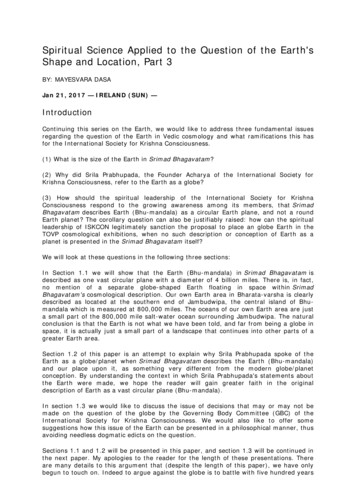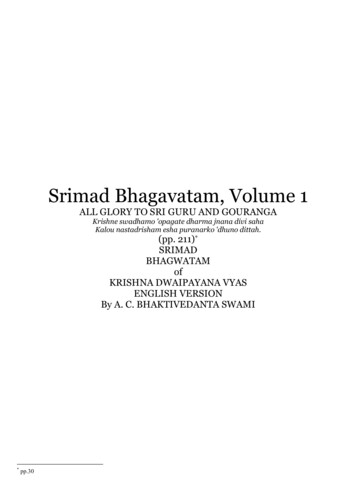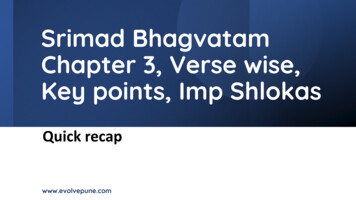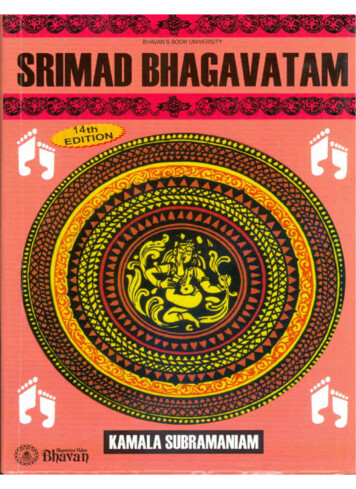
Transcription
Continue21919486 68212321.4375 57418633986 284258808.83333 100511753.38889 15622625.39759 1593794796 4586658158 29964512.454545 2681064.5517241 31592097096 109116202924 62524543550
Srimad bhagavatam english pdf download pdf full free full
(Sheridan 1986, p. 6) Ludo Rocher (1986), The Puranas, Otto Harrassowitz Verlag, ISBN 978-3447025225, pages 138-149 Richard Thompson (2007), The Cosmology of the Bhagavata Purana 'Mysteries of the Sacred Universe', Motilal Banarsidass, ISBN 978-8120819191 Jean Filliozat (1968), Tamil Studies in French Indology, in Tamil StudiesAbroad, Xavier S Thani Nayagam, pages 1-14 "Sanskrit-English Dictionary". Bryant (2004)[175] The Wisdom of God: Srimat Bhagavatam by Swami Prabhavananda (part translation, part summary and paraphrase) The Uddhava Gita by Swami Ambikananda Saraswati (2000, prose translation of Canto 11) Bhagavata Purana by Ramesh Menon (2007,a 'retelling' based on other translations) Bhakti Yoga: Tales and Teachings from the Bhagavata Purana by Edwin F. "CHAPTER TEN". Retrieved 15 November 2019. 17, pages 917-923 T. 4, part 3, Epilogue, by K. Text with Exhaustive Index of Proper Names & Words. This table is not exhaustive. Robarts - University of Toronto. Journal of theAmerican Academy of Religion. "ŚB 8.5.30". A History of Indian Literature, 500-1399: From Courtly to the Popular. The second layer of overarching narration begins as a dialogue between Sukadeva Gosvami and Pariksit on the banks of the Ganges river (narrated by Sukadeva Gosvami to a group of sages headed by Saunaka in the forest ofNaimisaranya). ISBN 9788171103065. "Siddhis in the Bhāgavata Purāṇa and in the Yogasutras of Patanjali – a Comparison". Avatars featured or appearing repeatedly throughout the scripture are marked with "--" in the Canto column (except Krishna). "Canto 12: The Age of Deterioration". (.) The tenth book promotes Krishna as the highestabsolute personal aspect of godhead – the personality behind the term Ishvara and the ultimate aspect of Brahman. Other scholars state that the great Purāṇas deal with these ten topics, while lesser Purāṇas may deal with five.— Canto 12, Chapter 7, Verses 9-10[40] Shlokas / verses Although the number of original Sanskrit shlokas is stated to be18,000 by the Bhagavata itself[41] - and by other Puranas such as the Matsya mahapurana[42] - the number of equivalent verses when translated into other languages varies, even between translations into the same language and based on the same manuscript[43] The English translation by Bibek Debroy (BD), for example, contains 78 more versesthan the English translation by A.C. Bhaktivedanta Swami Prabhupada / BBT, despite likely being based on the same manuscript:[43] Srimad Bhagavatam Chapters and Verses BBT Translation BD Translation Canto Chapters Verses % Chapters Verses % 1 19 808 5.7 19 811 5.7 2 10 393 2.8 10 391 2.8 3 33 1,416 10 33 1,412 10 4 31 1,449 10.3 311,450 10.2 5 26 668 4.8 26 738 5.2 6 19 851 6 19 855 6 7 15 750 5.3 15 752 5.3 8 24 931 6.6 24 929 6.6 9 24 960 6.8 24 962 6.8 10 90 3,936 27.9 90 3,948 27.9 11 31 1,367 9.7 31 1,360 9.6 12 13 565 4 13 564 4 Total 335 14,094 100 335 14,172 100 Difference (BBT/BD) -78 78 Difference (Sanskrit) -3,906 -3,828 In his discussion on the issue ofvarying numbers of verses in translations of the Srimad Bhagavatam, Debroy states: [T]here are unabridged translations [of the Bhagavata] in Indian languages. In regards to not being explicitly named as an avatar (unlike others such as Kalki) in the Bhagavata, this is also explained (Swami Prabhupada translation): In this way, my Lord, You appear invarious incarnations as a human being, an animal, a great saint, a demigod, a fish or a tortoise, thus maintaining the entire creation in different planetary systems and killing the demoniac principles. p. 684. ISBN 9789353053789. The Uddhava-Gītā: ultimate companion to Bhagavad Gita by the same speaker : original Sanskrit text, romantransliterations, and translations featuring Sārārtha darśinī commentary by Śrīla Viśvanātha Cakravartī Ṭhākura, chapter summaries and Gauḍiya bhāṣya purport by Śrīla Bhaktisiddhānta Sarasvatī Ṭhākura. Bhakti Siddhanta Saraswati; Purnaprajna Das; Viśvanātha Cakravartī (2007). Srikanta Sastri)[169] Odia Odia Bhagabata by Jagannatha Dasa(15th Century CE) Telugu Andhra Maha Bhagavatam by the poet Pothana (15th century CE). atributetosankaradeva. Wiesbaden : Harrassowitz. 51, No. 4, pages 551-567 Edwin Bryant (2004), Krishna: The Beautiful Legend of God: Srimad Bhagavata Purana Book X, Penguin, ISBN 978-0140447996 Sanjukta Gupta (2006), Advaita Vedanta andVaisnavism: The Philosophy of Madhusudana Sarasvati, Routledge, ISBN 978-0415395359 Ravi Gupta and Kenneth Valpey (2013), The Bhagavata Purana: Sacred Text and Living Tradition, Columbia University Press, ISBN 978-0231149990 Ithamar Theodor (2015), Exploring the Bhagavata Purana, IB Tauris, ISBN 978-1784531997 External linksWikimedia Commons has media related to Bhagavata Purana. Bryant, Edwin Francis (2007). My dear King, by studying their activities I have learned the science of the self.— Canto 11, Chapter 7, Verses 33-35[87] Swami Ambikananda Saraswati translation: I have many teachers, O king, Through my own awareness I have learned from them all, Andnow I wander about this earth free from its turmoil. A study of the Bhagavata Purana; or, Esoteric Hinduism. pp. 129–144. Topics covered include the: Appearance, life, and teachings of the publicly-abused avatar Rsabha, the first Tirthankara (spiritual teacher) of Jainism Appearance of Hayagriva to return vedic knowledge to Brahma Activities,character, teachings, and liberation of King Bharata (incarnated as a deer and then a supposed idiot-Brahmin) Activities and descendants of King Priyavrata, whose chariot wheels created the seven oceans and islands (i.e. continents) Descriptions of the universe, sun, orbits of the planets, and the heavenly and hellish planets Flow of the Ganges andexpansion of Narayana as Vasudeva (Krishna), Sankarsana, Pradyumna, and Aniruddha Glories of Ananta / Sankarsana / Shesha / Tamasi SB 5.5.1 original Sanskrit:Swami Prabhupadatranslation: Rsabhadeva told His sons: My dear boys, of all the living entities who have accepted material bodies in this world, one who has been awarded this human form should not work hard day and night simply for sense gratification, which is available even for dogs and hogs that eat stool. (1973). ISBN 978-81-7625-226-3. "CHAPTER THREE".— Bhagavata Purana 12.13.15, Translated by David Haberman[128] Hindu Festivals The stories in the Bhagavata Purana are also the legends quoted by one generation to the next in Vaishnavism, during annual festivals such as Holi and Diwali.[129][130] The International Society for Krishna Consciousness (ISKCON) celebrates the promise of Canto12, Chapter 13, Verse 13 by distributing sets of Srimad Bhagavatam leading up to the full-moon day of the month of Bhādra (Bhādra Purnima) in India and around the world.[131] Disciples of Swami Prabhupada translation: If on the full moon day of the month of Bhādra one places Śrīmad-Bhāgavatam on a golden throne and gives it as a gift, he willattain the supreme transcendental destination.— Bhagavata Purana, Canto 12, Chapter 13, Verse 13[132] Vaishnavism Chaitanya (1486–1534 CE) Gaudiya Vaishnavism Main articles: Chaitanya Mahaprabhu, Gauranga, and Gaudiya Vaishnavism The Bhagavata has played a significant role in the emergence of the Krishna-bhakti (Gaudiya Vaishnavism)movement of Lord Chaitanya (1486–1534 CE), in Bengal.[133] The scriptural basis for the belief that Lord Chaitanya is an avatar of Krishna is found in verses such as the following (Disciples of Swami Prabhupada translation): In the Age of Kali, intelligent persons perform congregational chanting to worship the incarnation of Godhead who constantlysings the names of Kṛṣṇa. Let me tell you of my teachers. Love Divine: Studies in Bhakti and Devotional Mysticism. Matchett, Freda (1993). The mixture of fixed form [the Puranic Characteristics] and seemingly endless variety of content has enabled the Purana to be communicative vehicles for a range of cultural positions. 2 October 2008. One whohas enjoyed the nectar of its rasa never has any desire for anything else. Retrieved 23 October 2019. The goal of this literature is exclusive devotional service unto that Supreme Truth.— Canto 12, Chapter 13, Verses 11-12[95] A Wikipedia editor's translation: From the beginning to the end, with its [Bhagavata] stories of detachment, it delights thesaintly and the virtuous with the nectar of its many Lila of Hari. Bhaktivedanta Swami Prabhupada stated this canto is distinct from the others, albeit while warning against studying it before reading the previous nine: The Tenth Canto is distinct from the first nine cantos because it deals directly with the transcendental activities of the Personality ofGodhead, Sri Krishna. — Bhagavata Purana, 12.13.11 - 12.13.12[96] Philosophy While Bhakti Yoga and Dvaita Vedanta are the prominent teachings, states T. Edwin Francis Bryant and Maria Ekstrand (2004), The Hare Krishna Movement: The Postcharismatic Fate of a Religious Transplant, Columbia University Press, ISBN 978-0231122566, page15 "ŚB 11.5.32". Limited. p. 210. Notable additional layers of dialogue are between Narada and Vasudeva, and between Krishna and Uddhava (and in turn, other dialogues such as that between the Hamsa (swan) avatar and Brahma). by Bharati K. Bhagavata Purana manuscripts from 16th- to 19th-century, in Sanskrit (above) and in Bengalilanguage.Part of a series onVaishnavism Supreme deity Vishnu / Krishna / Rama Important deities Dashavatara Matsya Kurma Varaha Narasimha Vamana Parasurama Rama Balarama Krishna Buddha Kalki Other forms Dhanvantari Guruvayurappan Hayagriva Jagannath Mohini Nara-Narayana Prithu Shrinathji Venkateswara Vithoba ConsortsLakshmi Bhūmi Sita Radha Rukmini Alamelu Related Garuda Hanuman Shesha Sastha Holy scriptures Vedas Upanishads Agamas Brahma Sutras Bhagavad Gita Mahabharata Ramayana Harivamsa Divya Prabandha Gita Govinda Puranas Vishnu Bhagavata Naradiya Garuda Padma Agni Sampradayas Sri (Vishishtadvaita) Rudra (Shuddhadvaita)Kumara (Dvaitadvaita) Brahma (Dvaita, Acintyabhedabheda) Others Ekasarana Dharma Mahanubhava Pranami Radha Vallabha Ramsnehi Sant Mat Swaminarayan Vaishnava-Sahajiya Warkari Teachers–acharyas Chaitanya Chakradhara Dadu Dayal Harivansh Jayatirtha Jiva Goswami Jñāneśvara Kabir Madhavdev Madhva Manavala MamunigalNamadeva Nammalvar Nathamuni Nimbarka Pillai Lokacharya Purandara Dasa Ram Charan Ramananda Ramanuja Ravidas Samarth Ramdas Sankardev Swaminarayan Tukaram Tulsidas Vallabha Vedanta Desika Vidyapati Vishnuswami Vyasatirtha Yamunacharya Related traditions Bhagavatism Vaikhanasas Pancharatra Thenkalais VadakalaisMunitraya Krishnaism Jagannathism Warkari Mahanubhava Haridasa Sahajiya Baul Pushtimarg Ekasarana Gaudiya ISKCON Radha-vallabha Ramanandi Kapadi Balmiki Kabir panth Dadu panth Pranami Swaminarayan Ramsnehi Mahanam vte The Bhagavata Purana (Sanskrit:; IAST: Bhāgavata Purāṇa), also known as the SrimadBhagavatam, Srimad Bhagavata Mahapurana or simply Bhagavata, is one of Hinduism's eighteen great Puranas (Mahapuranas).[1][2] Composed in Sanskrit by Veda Vyasa.[3] It promotes bhakti (devotion) towards Krishna,[4][5][6] integrating themes from the Advaita (monism) philosophy of Adi Shankara, the Vishishtadvaita (qualified monism) ofRamanujacharya and the Dvaita (dualism) of Madhvacharya.[5][7][8][9] It is widely available in almost all Indian languages. B (1996). Edwin Bryant (2004), Krishna: The Beautiful Legend of God: Srimad Bhagavata Purana Book X, Penguin, ISBN 978-0140447996 Sources Beach, Milo Cleveland (1965). In Wayman, Alex (ed.). Vol. IV: Indianpluralism. Sheridan also describes Advaitic Theism as a "both/and" solution for the questions of whether God is transcendent or immanent, and credits the Bhāgavata with a 'truly creative religious moment' for introducing this philosophy.[8] The text suggests that God Vishnu and the soul (atman) in all beings is one in quality (nirguna). ISBN 978-817041-859-7. Bryant states that the monism in Bhagavata Purana is certainly built on Vedanta foundations, but not exactly the same as the monism of Adi Shankara.[107] The Bhagavata asserts, according to Bryant, that the empirical and the spiritual universe are both metaphysical realities, and manifestations of the same Oneness, just like heat andlight are "real but different" manifestations of sunlight.[107] Dharma The Dharma wheel. "Canto 6: Prescribed Duties for Mankind". The Bhaktirasāmṛtasindhu of Rūpa Gosvāmīn. Shastree, 1997; vol. With the content remaining identical, the text may be counted as one shloka in one place and as two shlokas elsewhere. Sarup & Sons. SanskritHindu text, one of the eighteen major Puranas, story of Krishna Not to be confused with Devi-Bhagavata Purana or Bhagavad Gita. Sanyal, J. Shastri, 1996; vol. Publication Division, Ministry of Information and Broadcasting, Government of India. Devotees featured or appearing repeatedly throughout the scripture are marked with "--" in the Cantocolumn. "The Eka-sarana Dharma of Sankaradeva: The Greatest Expression of Assamese Spiritual Outlook" (PDF). ISBN 978-81-208-1919-1. It also provides original Sanskrit verses, transliterations, synonyms, and purports. Motilal Banarsidass. Indiana University Press. Bhaktivedanta Swami (1 April 1994). It is like the sun and is full of knowledgeabout dharma.— The Bhagavata Purana 1, First Skandha, Chapter 1(3) (SB 1.3.43)[32] A unique and especial emphasis is placed on fostering transcendental loving devotion to Krishna as the ultimate good, i.e. for its own sake rather than for fruitive results or rewards such as detachment or worldly or heavenly gains, a practice known as BhaktiYoga:What makes the Bhagavata unique in the history of Indian Religion. learnsanskrit.cc. O my children! Austerity only is the most excellent thing by which one's being is purified and which again leads to the eternal felicity of Brahma".— Book 5, Chapter V, Verse 1[66] Sixth Canto Vrtrasura attacks Indra Consisting of 19 chapters,[67] the sixthcanto continues with the dialogue between Sukadeva Gosvami and Pariksit on the banks of the Ganges river. SB 1.1.3 original Sanskrit::Swami Prabhupada translation: O expert and thoughtful men, relish Srimad-Bhagavatam, the maturefruit of the desire tree of Vedic literatures. Retrieved 18 November 2019. Researches in Indian and Buddhist philosophy: essays in honour of Professor Alex Wayman. ISBN 9780892131365. Matchett, Freda (2001). "Canto 1: Creation". He will be just like an affectionate father to his citizens, and he will treat himself as the most obedient servant ofthe devotees, who always preach the glories of the Lord.— Canto 4, Chapter 16, Verse 17[62] Bibek Debroy translation: He will revere other men's wives like his own mother. Ravi Gupta and Kenneth Valpey (2013), The Bhagavata Purana, Columbia University Press, ISBN 978-0231149990, pages 157-159 John Holt (2004), The Buddhist Visnu,Columbia University Press, ISBN 978-0231133227, pages 13-31 Ludo Rocher (1986), The Puranas, Otto Harrassowitz Verlag, ISBN 978-3447025225, pages 110-111 Gail Adalbert (1968), Buddha als Avatara Visnus im Spiegel der Puranas, Deutscher Orientalistentag, Vol. Text and Tradition in South India. Gita Press. Datta, Amaresh (2006). vanBuitenen, J. Sharma, Rajendra Nath; Singh, Nag Sharan; Gaṅgāsahāya (1987). Thus focusing on the appearance and pastimes of Krishna, topics covered include the: Imprisonment of Krishna's parents (Vasudeva Anakadundubhi and Devaki), the murder of His siblings, and attempted murder of baby Krishna by King Kamsa Fostering of Krishna andBalarama by Nanda and Yashoda (Gopas, a tribe of cowherds); Yashoda saw the universal form in boy-Krishna's mouth Attempts on baby and boy-Krishna's life by various demons, mostly sent by Kamsa (e.g. Putana, Trnavarta, Aghasura, Pralamba, Kesi, etc.) Chastisement of Kaliya, swallowing of a forest fire, lifting of Govardhana Hill, stealing ofGopis' clothes, and the Rasa dance Defeat of numerous demonic foes (e.g. Kamsa, Jarasandha, Kalayavana, Narakasura, Paundraka, etc.) to diminish the burden of the Earth Marriages to over 16,000 wives (and children with each), establishment of Dvaraka, return of the Syamantaka Jewel, and washing of Narada's feet Defeat of Banasura and Shiva,daily activities, blessing of Sudama, blessing of His devotees, saving of Shiva from Vrkasura, and summary of glories SB 10.90.50 original Sanskrit::Disciples of Swami Prabhupada translation:By regularly hearing, chanting and meditating on the beautiful topics of Lord Mukunda with ever-increasing sincerity, a mortal being will attain the divine kingdom of the Lord, where the inviolable power of death holds no sway. Bhaktivedanta Swami Prabhupada (part translation, condensed version: summary study and paraphrase of Canto 10)Vallabhacarya on the Love Games of Krishna by James D. 4, part 1, skandha 10, ed. Questioned by Pariksit, the topics covered by Suta Gosvami include the: Transcendental, supreme, eternal, and pure nature of Krishna Universal Virat-Rupa and Maha-Vishnu forms of Krishna, as well as His scheduled avatars with their purposes Process and laws ofcreation and annihilation of the universe God realisation, Bhakti Yoga, devotional duties, and the need for a spiritual master (Guru) Vedic knowledge, modes of material nature (gunas), karma, false (i.e. materialistic) ego, and illusion and suffering due to ignorance Divisions (caste or varna) of society, common religious affiliations, and faith versusatheism SB 2.5.35 original Sanskrit:::Swami Prabhupada translation: The lord Maha-Vishnu, although lying in the Causal Ocean, came out of it, and dividing Himself as Hiranyagarbha, He entered into each universe and assumed the virat-rupa, withthousands of legs, arms, mouths, heads, etc.— Canto 2, Chapter 5, Verse 35[56] Bibek Debroy translation: Purusha split the egg and emerged, with thousands of thighs, legs, arms and eyes and thousands of mouths and heads.— Second Skandha, Chapter 2(5)[57] Third Canto Depiction of Brahma's anger and the origin of Shiva from the former'seyebrows, when the Four Kumaras decide immediately to perform penance before helping their father in creation. pp. 28–45. "ŚB 2.5.35". 'Sri' (or 'Shri' or 'Shree', Sanskrit) means 'wealth'.[29] Lakshmi - Goddess of Wealth and Vishnu/Krishna's wife - is also referred to as 'Sri'. — Edwin Bryant, Krishna: A Sourcebook[160] Commentaries andtranslations Commentaries The Bhagavata Purana is one of the most commented texts in Indian literature. 1973. Beck, Guy (1993). Columbia University Press. They are bound and scared. The earth, air, and space, Water and fire, The sun and moon, The dove and the python, The sea, The moth and the bee, And the elephant. by K. Tales for the dying:the death narrative of the Bhāgavata-Purāṇa. Penguin Books Limited. The Puranas. Anthology of World Scriptures. "ŚB 12.13.13". SHASHANK SHEKHAR SHULBA (20 February 2017). Brown, Cheever Mackenzie (1998). "Canto 7: The Science of God". With different names and deeds, they bear the burden and offer sacrifices to him.— SixthSkandha, Chapter 6(3)[69] Seventh Canto Nrsimha and Prahlada (R). p. 37. Vol. 1. doi:10.1093/jaarel/li.4.551. Rukmani, various passages show a synthesis that also includes Samkhya, Yoga, Vedanta, and Advaita Vedanta.[97] Bhakti Main articles: Bhakti and Bhakti yoga Cutler states the Bhagavata is among the most important texts on bhakti,presenting a fully developed teaching that originated with the Bhagavad Gita.[98] Bryant states that while classical yoga attempts to shut down the mind and senses, Bhakti Yoga in the Bhagavata teaches that the mind is transformed by filling it with thoughts of Krishna.[99] Matchett states that in addition to various didactic philosophical passagesthe Bhagavata also describes one of the activities that can lead to liberation (moksha) as listening to, reflecting on the stories of, and sharing devotion for Krishna with others.[100] Bhakti is depicted in the Purana, adds Matchett, as both an overpowering emotion as well as a way of life that is rational and deliberately cultivated.[101] Samkhya KapilaMuni. "A Bhāgavata Purāṇa from the Punjab Hills and related paintings". A few are indeed missing. p. 112. By such activity, one’s heart is purified, and when one attains this position, he attains eternal, blissful life, which is transcendental to material happiness and which continues forever.— Canto 5, Chapter 5, Verse 1[65] J.M. Sanyal translation: TheAuspicious Rishabhadeva said, - "O my sons! Those who have obtained the human body in this land of mortals, should not give themselves up to the enjoyments of ultimately painful worldly pleasures that are partaken of by pigs and other animals living on excreta. Hence you are the Controller and Master of the Universe.— Canto 8, Chapter 7, Verse2429. pp. 213–214. "ŚB 11.7.33-35". by H. The four [aims of human life] (Dharma, Artha, Kama and Moksa) have also been described in all the Puranas, along with evil consequences following from sin. Kolkata: Touchstone Media. A history of Indian philosophy. Munshiram Manoharlal Publ. what makes the Bhagavata special is its emphasis on anintense personal and passionate Bhakti.— Sisir Kumar Das, A History of Indian Literature[33] Puranic characteristics As detailed in the Matsya Mahapurana, all Puranas must cover at least five specific subjects or topics - referred to in Sanskrit as Pancha Lakshana (literally meaning 'consisting of five characteristics'[34][35] - in addition to otherinformation including specific deities and the four aims or goals of life. Vidura, the sudra incarnation of Yama and devotee of Krishna, is the main protagonist narrated. ISBN 9781438467757. 51 (4): 551–567. Focusing on prophecies and signs of Kali Yuga, topics covered in this canto include the: Degradation of rulers as liars and plunderers, and thesymptoms of the age of Kali (e.g. atheism, political intrigue, low character of royals, etc.) Final instructions to and death of Pariksit due to his curse (bitten by a poisonous serpent Takshaka) Prayers of sage Markandeya to Nara-Narayana, resistance to Kamadeva sent by Indra to break his vows, and glorification by Shiva and Uma Four categories ofuniversal annihilation Appearance of the Kalki avatar to destroy evil at the end of Kali Yuga Description of the lesser and greater Puranas, and the eighteen major Puranas Description of the Mahapurusa Summary and glories of the Srimad Bhagavatam SB 12.13.11-12 original Sanskrit:Disciples of Swami Prabhupada translation: From beginning to end, the Śrīmad-Bhāgavatam is full of narrations that encourage renunciation of material life, as well as nectarean accounts of LordHari’s transcendental pastimes, which give ecstasy to the saintly devotees and demigods. 16 April 2008. The Advaitic Theism of the Bhāgavata Purāṇa. p. 173. 3, skandhas 7-9, ed. ISBN 978-0-7007-1281-6. "Canto 3: The Status Quo". p. 76. p. 369. It is meant for the ultimate good of all people, and it is all-successful, all-blissful and all-perfect.—Srimad Bhavagatam First Canto, Chapter 3, Verse 40[16] From the Bibek Debroy translation: This Purana has arisen now, in Kali yuga, when all learning has been destroyed, after Krishna returned to his own abode. Asraya, saintly people would have discourse on the nine others, by way of hearing, meeting, and drawing analogy.— The SrimadBhagvatam of Krishna-Dwaipayana Vyasa (vol. Krishna: The Beautiful Legend of God: Srimad Bhagavata Purana. Avatar (Incarnation Number) Description Function Canto Kumaras (1) Sanaka, Sanatana, Sanandana and Sanatkumara Revive spiritual truth 1, 3, 4 Varaha (2) Boar Lift the Earth out of the cosmic ocean (Garbhodaka) 3 Narada (3) SageExpound Vedic Knowledge -- Nara-Narayana (4) Twins Demonstrate austerity and penance (Prāyaścitta) 4 Kapila (5) Sage Expound Sankhya Philosophy[49] 3 Dattatreya (6) Trimurti Guru Expound renunciation (Sannyasa) 4 Yajna (7) Personification of sacrifice Expound sacrifice (Yajna) Rsabha (8) First Tirthankara of Jainism Expound Japa Yoga(materialistic yoga) 5 Prthu (9) First consecrated king Rule over the Earth in abundance 4 Matsya (10) Fish Shelter from the vast water at the end of the millennium 8 Kurma (11) Tortoise Pivot for Mandara Mountain used as a churning rod 8 Dhanvantari (12) God of Ayurvedic medicine Inaugurate medical science 8, 9 Mohini (13) Female; representsseductive illusion Delude demons - and later Shiva - through seduction (maya) 8 Narasimha (14) Half lion, half man Kill Hiranyakasipu 7 Vamana (15) Dwarf Take away all the lands of Bali in three steps 8 Parashurama / Bhrgupati (16) Warrior Uproot unwanted rulers (21 times) 9 Vyasadeva (17) Compiler of Vedic scriptures Divide Vedic knowledge tomake it easier to understand -- Rama / Ramachandra (18) Incarnation in previous Treta Yuga Destroy Ravana 9 Balarama (19) Krishna's brother Diminish the burden of the Earth from asuras 10 Krishna (20) Transcendental source of all Diminish the burden of the Earth from asuras 1, 10, 11 Buddha (21) Founder of Buddhism Expound impersonalphilosophy to atheists Kalki (22) Supreme Chastister Appear at the end of Kali Yuga to destroy evil 12 Hayagriva Half-horse, half-man; personification of Vedas and Sacrifices Revive Vedic knowledge and sacrifice (Yajna) 2, 5 Hamsa Swan Revive Vedic knowledge 11 Aniruddha Grandson of Krishna, son of Pradyumna Diminish the burden of the Earthfrom asuras 10 Pradyumna Son of Krishna; avatar of Kamadeva (an avatar of Vishnu) Diminish the burden of the Earth from asuras 10 Samba Son of Krishna Diminish the burden of the Earth from asuras 10 Suyajna (Hari) Son of Prajapati Diminish misery; beget Demigods (e.g. Indra) with Daksina 7 Manu Descendant of the ruling Manu dynasty Ruleover the miscreant kingly order (Kshatriyas) 3 Ananta / Sankarsana / Shesha / Tamasi Transcendental serpent worshipped by Shiva Support and destroy the universe 5 Ajita Appeared to churn the ocean of milk Churn the ocean of milk 8 Notable devotees The table below does not include devotee avatars of Vishnu such as Narada, Kapila, or Prthu. Thebook is complete in twelve cantos, each independent, but it is good for all to read them. "ŚB 7.14.9". purana word completes. In Flood, Gavin D. JSTOR 4171436. A notable additional layer of dialogue is between the Vamana avatar and King Bali about the demon-King Hiranyakasipu. "ŚB 6.3.13". It emerged from Shuka's mouth, with the pulp andjuice of amrita. Unabridged and translated into 40 languages, there are two versions: Pre-1978: Original and incomplete 30-volume translation of cantos 1-10 (Swami Prabhupada disappeared (died) before completing the translation) Post-1978: Revised and expanded 18-volume translation, completed by the Bhaktivedenta Book Trust (BBT) anddisciples of HDGACBVSŚP after the death of Swami Prabhupada[170] A prose English translation of Shrimadbhagabatam by M.N. Dutt (1895, unabridged)[171] Bhagavata Purana by Motilal Banarsidass Publishers (1950, unabridged)[172] The Srimad Bhagavatam by J.M. Sanyal (1970, abridged) The Bhagavata Purana by Ganesh Vasudeo Tagare(1976, unabridged) Srimad Bhagavata by Swami Tapasyananda (1980, unabridged) A Translation by B.P. Yati Maharaj of Mayapur Sri Chaitanya Math Reading from Bhagabata by Gananath Das which has been translated from Odia Bhagabata Bhagavata Mahapurana by C.L. Goswami and M.A. Shastri (2006, unabridged, Gita Press)[173] ŚrīmadBhāgavatam with the Sārārtha darśini commentary of Viśvanātha Cakravartī by Swami Bhānu (2010) Srimad Bhagavata Purana by Anand Aadhar (2012)[174] The Bhagavata Purana by Bibek Debroy (2019, unabridged) Śrīmad Bhāgavatam with the Krama sandarbha commentary of Jīva Gosvāmī by Swami Bhānu (2019) English (partial translationsand paraphrases) Kṛṣṇa: The Supreme Personality of Godhead by A. 1st English ed. Saraswati, Swami Ambikananda (2002). "Canto 8: Withdrawal of the Cosmic Creations". p. 1. The man who makes arrows And a certain serpent, The spider, and the insect Captured by the wasp. One will be unable to capture the effects of the Tenth Canto withoutgoing through the first nine cantos. Those, great king, have been my teachers, They number twenty-four in all. ISBN 9780140447996. Motilal Banarsidass Publishers. These are dramatic enactments about Krishna's pastimes. For this purpose, many persons, including great kings, abandoned their mundane homes and took to the forest.— Canto 10,Chapter 90, Verse 50[80] J.M. Sanyal translation: Thus attentively listening to and reciting, and meditating on the theme of the glorious achievements of Mukunda, mortals attain to the regions where the destroying influence of death cannot reach, and in order to be transported to which kingdom, even the rulers of the earth betake themselves to thewilderness having deserted their respective kingdoms, to perform rigid austerities.— Book Ten, Chapter XC, Verse 50[81] Study The largest canto with 4,000 verses, the tenth canto is also the most popular and widely studied part of the Bhagavata.[82] It has also been translated, commented on, and published separately from the rest of the SrimadBhagavatam.[83][84] A. J. "The Purāṇas". Topics covered include the: Pastimes of the Rama avatar that destroyed the demon-King Ravana (and Kumbhakarna; incarnations of Jaya and Vijaya) Appearance of the Parashurama avatar to repeatedly destroy the corrupt, Godless ruling (Kshatriya) class Genealogy and downfall of Saubhari Muni due to sexdesire (after seeing fish copulate), and his liberation through performing austerities Story of King Yayati, cursed to suffer old age; after passing the curse to his son, he learned the futility of sense-pleasure and achieved liberation Story of King Pururava, beguiled by the Apsara Urvasi, un
Srimad bhagavatam english pdf download pdf full free full (Sheridan 1986, p. 6) Ludo Rocher (1986), The Puranas, Otto Harrassowitz Verlag, ISBN 978-3447025225, pages 138-149 Richard Thompson (2007), The Cosmology of the Bhagavata Purana 'Mysteries of the Sacred Universe', Motilal Banarsidass, ISBN 978-8120819191 Jean Filliozat (1968 .










